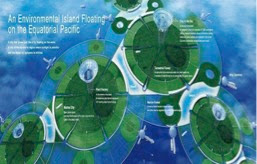The surface of planet Earth is 29% land and 71% oceans, and by volume oceans account for 99% of its living space. Only about 30% of the total land area is used for human habitation, and of this about half is for agriculture. The production of animal protein for food accounts for 70% of agricultural land use. Taking up far less land space, seafood production, wild-caught and farmed, now supplies 30% of total protein consumption, more than from animal protein. Yet the world population is expected to grow from 7 billion to over 10 billion persons by 2050. With most fisheries already near depletion, and any increase in animal protein production limited, global food security in the future may be in jeopardy.
Aquaculture production of seafood in the U.S. accounts for less than 2% of the world’s farmed seafood total, as the U.S. has lagged as a major importer. Under the UN Law of the Sea (UNCLOS), ocean-bordering nations have territorial jurisdiction of coastal waters extending to 12 miles offshore, and economic jurisdiction over their exclusive economic zones (EEZ) extending to 200 miles out in ocean waters. If ocean farming is expanded to just 20% of the temperate EEZ zones of ocean-bordering nations, it could supply all of the increased world food needs by 2050 with farmed seafood.
The oceans also have wind, ocean thermal, and tidal energy resources that can provide renewable electrical power to commercial-scale ocean farms in EEZ-permitted ocean farming zones. Ocean thermal energy conversion (OTEC), first demonstrated by researchers in Hawaii in 1993, can use the temperature differential of cold deep water pumped to the surface to provide electricity to ocean farms renewably and sustainably, and carbon-free. OTEC power can also be made transportable by conversion of hydrogen fuels, and also produce desalinated water as by-product. Its enriched (decompressed) cold water discharge can be used in ocean farming for growing plankton, seagrass and feeder fish to feed higher-order farmed fish and other seafood products.
Having available carbon-free, renewable ocean energy and commercial-scale farmed seafood production supported on large ocean platforms could lead to the eventual building of ocean cities. As sea levels could rise 8 feet globally by 2100 as polar icecaps melt, some coastal cities and island nations are already preparing for relocation to ocean cities.
A first-of-its-kind Pacific International Ocean Station (PIOS) is proposed for deployment in a far offshore zone of the Southwest Hawaiian EEZ off NELHA on Hawaii Isle. PIOS is envisioned as a pilot station for testing best practices and technologies for OTEC and ocean farm systems as a model for ocean resources development in the U.S. and worldwide. In the vastness of the oceans’ resources lies our future. A “Blue Revolution” of sharing the natural bounty of the oceans renewably and sustainably has promising potential to provide for human needs worldwide in the future.
Ocean farming to solve world food needs & global warming
Blue Revolution Hawaii, Inc., based in Honolulu, HI, is a non-profit advocacy group for renewable, sustainable, eco-friendly, and carbon-free ocean resources development. Leighton Chong retired from intellectual property law practice after 2016, and has been COO & Counsel for the organization and its independently organized TEDx Countdown events produced under license.







No comments:
Post a Comment